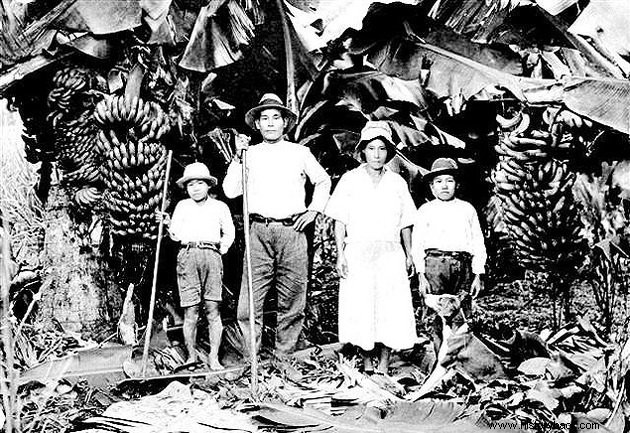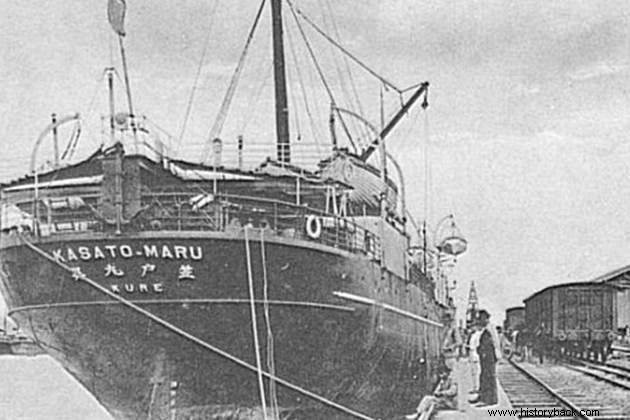The Japanese immigration in Brazil began on June 18, 1908 with the arrival of the first Japanese ship, Kasato Maru, in the port of Santos.
Background
At the end of the 19th century, with the Meiji Revolution (1868), Japan opened up to the world and changed its social organization.
In this way, the taxes levied on peasants increased, forcing thousands of people to go to the city. Likewise, the population had grown and the Japanese government began to encourage immigration to America.

Meanwhile, Brazil was also undergoing profound changes. With the end of the slave trade in 1850, the price of an enslaved person increased and planters began to hire European immigrant labor to supply the lack of slaves.
Thus, we realize that the stimulus to bring immigrants to Brazil was due to racial prejudice. Coffee plantation owners preferred to pay a white foreigner to a black worker who already knew how to perform the task.
See also:End the African Slave TradeJapanese Immigration in the Republic
With the advent of the Republic, this policy of eliminating the African intensified. On October 5, 1892, Law nº 97 was approved, which allowed Japanese and Chinese immigration to Brazil.
It also provided for the opening of embassies and the conclusion of trade treaties between both countries.
Japan took an interest in this opening and Ambassador Fukashi Sugimura assumes his diplomatic post and examines the conditions in the country.
Very well received, Sugimura writes a report favorable to the coming of Japanese to Brazil. Subsequently, Japanese immigration is handed over to private companies.
The companies then advertised that the coffee tree was the "golden tree", harvesting it was an easy task and the immigrant would quickly get rich and return rich to Japan.
See also:Coffee CycleArrival of Japanese Immigrants

In 1908, the ship "Kasato Maru" docks in the Port of Santos, in São Paulo, bringing 781 Japanese. Singles were not allowed, only married people with children.
Japanese immigrants signed work contracts for 3, 5 and 7 years with the owners of the farms and, in case of non-compliance, they had to pay heavy fines.
Without speaking the language and without any infrastructure prepared to receive them, the Japanese immigrants realized that they had been deceived.
As the contracts ended, many left the coffee farms. Those who didn't want to wait, fled to big cities and other states like Minas Gerais and Paraná, where land was more affordable.
With patience and determination, the Japanese are able to farm in the countryside or open businesses in the city and stabilize their lives. It is estimated that 190,000 Japanese came to Brazil before World War II.
Japanese Immigration in World War II
During the 1940s, however, the scenario would quickly change. Brazil supported the United States and England in World War II (1939-1945) while Japan fought alongside Germany and Italy.
When Brazil declares war on the Axis countries in 1942, a series of laws will harm Japanese communities such as the closing of schools, associations, sports clubs and the use of Japanese national symbols.
In addition, they have their sales jeopardized, they are prohibited from meeting and several have had their properties and assets confiscated.
In state assemblies, the ban on the arrival of the “yellow element” to the country was discussed, as it would represent a danger to society.
In any case, Japanese immigrants would continue to arrive until the 1970s.
See also:racismInfluences
Japanese immigrants introduced new crops such as tea or silkworms in the Brazilian countryside. They perfect the cultivation of potatoes, tomatoes and rice and, for this reason, they were called "gods of agriculture".
They also brought religions such as Buddhism and Shintoism, traditional dances and martial arts such as judo and karate.
See also:Japanese cultureJapanese-Brazilian Personalities
Several immigrants and descendants of Japanese stood out in Brazil. Let's look at some examples:
- Haruo Ohara (1909-1999), farmer and photographer
- Tomie Ohtake (1913-2015), plastic artist and painter
- Yukishigu Tamura (1915-2011), politician
- Tikashi Fukushima (1920-2001), painter and draftsman
- Manabu Mabe (1924-1997), draughtsman, painter and upholsterer
- Tizuka Yamazaki (1949), filmmaker
- Hugo Hoyama (1969), athlete
- Lincoln Ueda (1974), athlete
- Daniele Suzuki (1977), actress and presenter
- Juliana Imai (1985), model
Curiosities
- There are several institutions that preserve the memory of Japanese immigrants, such as the Historical Museum of Japanese Immigration in Brazil, in São Paulo or the Museum of Agricultural Colonization of Paraná, in Rolândia.
- In the city of São Paulo, the Liberdade neighborhood is a reference for Japanese commerce and culture.
- Brazil is the country with the largest population of Japanese outside Japan.
Read more:
- Immigration in Brazil
- Japan
- Japan's Economy
- Acculturation
- Meiji Revolution
